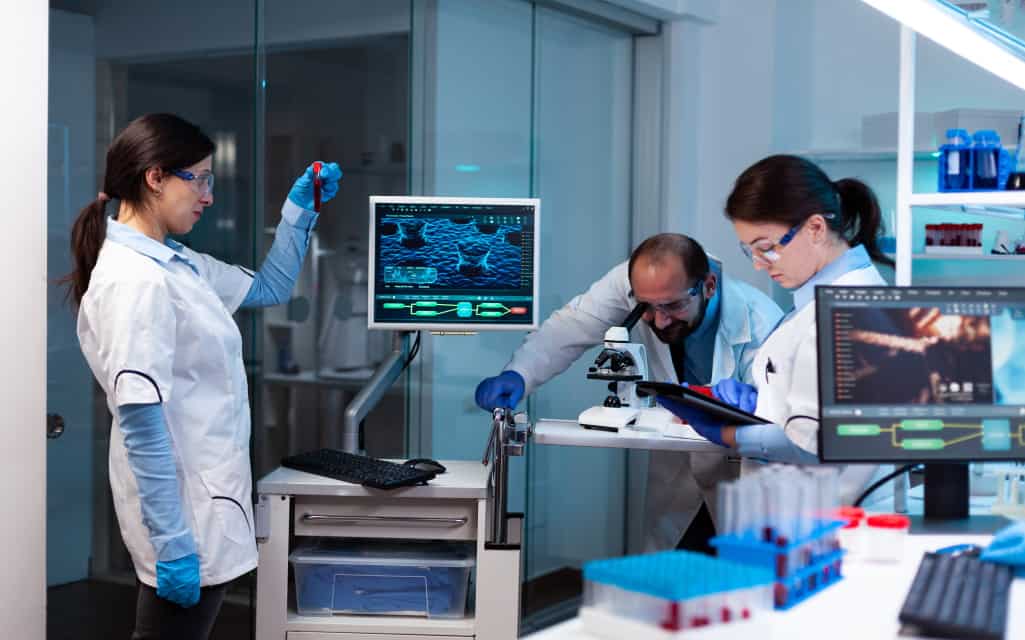College survey courses in biology aren’t all about coaxing students to learn the facts they need to get good scores on the MCAT or GRE. They aren’t all about teaching students the laboratory skills they will need as professionals in the field. But survey courses in college biology are, Modern Biology believes, a tremendous opportunity to give liberal arts and non-STEM majors an opportunity to learn and use scientific thinking skills.
Even deceptively simple experiments can give students in biology survey courses a chance to develop their scientific thinking skills.
For example, consider Modern Biology’s experiment manipulating actual DNA into visible strands.
That sounds really basic, doesn’t it?
The fact is, students can get into college survey courses without an intuitive understanding of what DNA is. They can see illustrations of the double helix in textbooks and online and learn all the vocabulary words their general science teachers assigned them, but still not have a kinesthetic experience of what DNA is.
But Modern Biology’s Experiment B1-1: Properties of DNA isn’t playtime.
Students precipitate DNA by adding alcohol to an aqueous solution of DNA. They can hypothesize about the effects of different reagents on this solution.
In this beginning exercise, survey biology students break long strands of DNA with a DNAse. You can challenge your students to formulate hypotheses to test with this simple lab, so it is not just a demonstration.
When your students complete this exercise, they are ready for Experiment B1: Structure, Isolation, and Function of DNA. In this experiment, they can learn techniques of cell fractionation, isolating DNA, and cloning genes. They can hypothesize about the effects of temperature and pH on the size of the strands. Then they can relate the number of base pairs to the molecular weight of a DNA molecule, and begin to devise their experiment using more advanced analytical methods, such as IND-24: An Introduction to Electrophoresis.
Understanding electrophoresis is a springboard for understanding molecular cloning. When students understand this technique, they will be ready for the relative length of strands of DNA. They can go on to identifying sex-specific proteins.
Mastering the concept of electrophoresis prepares students for a fun exercise like genetic engineering of E. coli with a luciferase gene in IND-09: Producing a Strain of E. coli that Glows in the Dark. Or they can build a bacterial computer. They can master basic skills of ELISA.
Your survey students can leave your course with a hands-on understanding of two fundamental diagnostic tools they are sure to encounter in their personal lives. At the very least, they will know what ELISA is and how important it is for their medical diagnosis and treatment.
And, if you have time in your term, you can use Modern Biology to give your survey biology students a capstone project like Modern Biology’s exercise on sickle cell anemia.
In this project, students test their own DNA for sickle cell traits. In the same way that people who take DNA tests from Ancestry or 1-2-3 and Me can be surprised by the results, some of your students may be surprised to learn of their own sickle cell status.
Students will learn that they carry no genes for sickle cell traits at all, or that they are heterozygous with a single abnormal allele, or, as they would almost certainly know before taking your class, that they are homozygous for both sickle cell genes. But the learning experience is in answering the larger questions that sickle cell trait poses.
Students will need to integrate concepts of population genetics, blood chemistry, and physiology. They will leave this capstone project with a clear understanding of genotype, phenotype, balance polymorphisms, and evolution. But they can gain a larger understanding of the importance of biological science in addressing issues of equity and access to medical care.
What is the real benefit of using Modern Biology in your survey biology classes?
Survey biology students who complete lab work with the Modern Biology curriculum can feel like they have mastered some of the skills of being a scientist, because they will employ scientific reasoning every time they go into the lab. They will also gain an intuitive understanding of significant digits. They will deal with real consequences from failure to follow instructions for the preparation of electrophoresis gels and diluting reagents. They will gain real experience working with test samples and controls.
This kind of learning is more important than retaining a list of facts about the biological sciences, although Modern Biology laboratory experiments are structured to help with that, too. Every experiment from Modern Biology is structured as an exercise in scientific thinking, not just as a demonstration of a scientific fact. Students must know the topic well enough to formulate a hypothesis, test it in the lab, record their result, and share their findings in writing.
Every kit from Modern Biology comes with all the test materials, control materials, reagents, and expendable lab supplies the class will need to do the exercise. There is nothing to order other than the experiment itself. There are no trips to the supply room, no requisitions of materials that may be in short supply, and no complicated accounting for lab materials.



